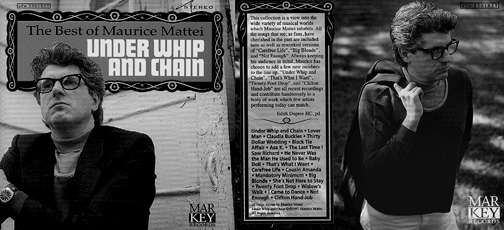The Under Whip And Chain CD is packaged as a greatest hits collection. It was becoming increasingly clear to me that my musical career would lead nowhere so I came up with the idea of treating it as a kind of extended conceptual art performance piece. The “greatest hits” format was a step in this process. I seldom got airplay and almost no one bought my music so assuming the role of a successful recording artist seemed appropriate. I often choose to wield my anonymity as some do their fame.
The collection consists of my favorite material from Grandview, Carefree Life and Mandatory Minimum, as well as a couple of songs from my old singles. To this, I added four new numbers. In all, the CD contains 20 cuts. Some of the tracks off the prior releases were re-recorded with additional accompaniment. It was the first time I had worked with other musicians since the mid-1980s. I enjoy this kind of collaboration because it always brings a different slant to the recording – as long as the musicians are given a reasonable amount of freedom. It’s never been my approach and I’ve never understood the idea of dictating exactly what someone else should play. I might offer direction but I don’t consider my view to necessarily have any more weight than anyone else’s.
At the time, I was listening to a lot of Jerry Lee Lewis from the Mercury years. He released a series of Country & Western LPs in the 1960s produced by Jerry Kennedy. They are great little records and I loved the sleeve designs as much as the music. That is where the idea for the cover of Under Whip And Chain came from. It may have been the first time I actually used a picture of myself in anything related to my music.

Under Whip And Chain CD
I tried to promote this CD more aggressively than the others. In retrospect it seems absurd but I actually bought ad space in The Willow, the Indie rag referred to earlier (see chapter 5), announcing its release. This, of course, garnered no increase in sales or recognition. The Willow’s music columnist, Mark Balustrade, gave it a very favorable notice but this too had no effect on sales or recognition. The few people who read record reviews rarely have the money to actually buy records by self-produced, unsigned performers that they’ve never heard of.
Under Whip And Chain also marked the first time I approached the local NPR stations with my music. There were two stations that occasionally slotted regional music into their rotations. Of the two, WUCK, broadcasting from the campus of Northern Kentucky University, was the most open to local artists. The other one, WHEY, also played local music but it had to fit into their Easy Listening/Windham Hill style programming. I thought of it as the Cuckold Rock station.
One of the DJs at WUCK was an acquaintance of Richard Burns, aka Rockin’ Ricky from WILT (see chapter 6), and Ricky had introduced us at a party at The Contemporary Cluster Art Gallery. His name was Rob Phyllis but he went by Mrs. Phyllis on his radio show. He played oldies much the same as Rockin’ Ricky but he had an entirely different personality. Where Ricky was compulsively organized in everything he did, Mrs. Phyllis was slovenly, sloppy and manic.
I called Mrs. Phyllis to see about the possibility of getting airplay for the CD and he arranged a meeting with the program director at WUCK. I found this peculiar but I went along with it because I didn’t know any better. Upon arriving, I was greeted by Mrs. Phyllis who told me that we’d have to wait because the program director was running behind schedule. We sat in a side room next to the studio and talked about nothing in particular. After 10 minutes or so, the program director arrived. He was wearing faded blue jeans and a Hawaiian shirt. His name was Jack O’Shea and he clearly thought he was important. I would not find out just how important until a few years later.
While Mr. O’Shea maintained his aloofness, the meeting proceeded with uneasy pleasantries. There was a point at which Mrs. Phyllis started pleading my case as a viable local recording artist. This valiant gesture didn’t make the dynamics of the situation any more comfortable or any less puzzling. I was questioned about the content of some of my songs, the meaning of the imagery used in the CD design, my thoughts about their station, my views on women, and lot of other things that seemed entirely irrelevant. I left there feeling completely bewildered by the whole experience. The odd self-importance of the program director combined with the overall sense of being examined and having to pass inspection all added up to something contrary to how this NPR station presented itself to the general public. I would one day come to understand that places like this only feign tolerance and inclusiveness. As a rule, these organizations are the ones least likely to accept ideas – or people – that don’t align with their points of view. Weeks later, friends told me they heard a song or two from Under Whip And Chain being played on WUCK. Whatever satisfaction I may have had from this was tempered by having met the schmucks who ran the station.
<<< Continue reading >>>
<<< Read the previous chapter
© 2013 by Maurice Mattei
All rights reserved.